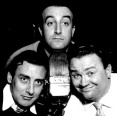|
Amazing thread. Has taken me a long time (weeks on and off), but I have finally got through it. I am surprised no one has asked you about the westbound cross county parkway to southbound 87 interchange (taking exit 4S). Use street view to get off the exit and get on 87. Every time I do it I cringe in fear. http://maps.google.com/maps?f=d&sou...300.21,,0,-2.74 Reasons: 1) Tight curve into a high-weave area, with other traffic going much faster 2) Then, after a while, you pass a Burger King, then a Getty, then a Shell, and end up at a stop light: http://maps.google.com/maps?daddr=4...1,,0,-2.74&z=18 3) Go straight at that light OH GOD YOU HAVE TO SHIFT LANES because at the light the left lane was left-turn only. Of course some drivers go STRAIGHT in the left-only lane, causing more fun. 4) It then ends with an on ramp that challenges some of the shortest on the merritt: http://maps.google.com/maps?daddr=4...1,,0,-2.74&z=18
|
|
|
|

|
| # ? Jun 7, 2024 21:13 |
|
BuckT.Trend posted:On a recent trip from Seattle to Whistler, every distance sign I saw had both English and the Native word for the location. That's why I was curious. Not familiar with BC. Toronto will throw up Chinese translations and stuff in Chinatown, etc. and Ontario puts French translation where highways pass through municipalities that are overwhelmingly bilingual.
|
|
|
|
BuckT.Trend posted:On a recent trip from Seattle to Whistler, every distance sign I saw had both English and the Native word for the location. That's why I was curious.
|
|
|
|
hoboslayer posted:Amazing thread. Has taken me a long time (weeks on and off), but I have finally got through it. I am surprised no one has asked you about the westbound cross county parkway to southbound 87 interchange (taking exit 4S). A lot of New York's interchanges haven't aged well. When a freeway needs to be widened, and the area is heavily developed, you have to start making sacrifices in geometrics. You MIGHT be able to put a 4-level stack in there, though it would be a little tight, and I'm sure the neighbors would complain.
|
|
|
|
BuckT.Trend posted:On a recent trip from Seattle to Whistler, every distance sign I saw had both English and the Native word for the location. That's why I was curious. They did it because basically the highway was upgraded for the Olympics and the First Nations were a huge part of it. And most of the highway is built on Native land. I believe it's the only highway in BC that has a language other than English on the signs.
|
|
|
|
The weather this week has been lovely, if a bit warm, so... Field Visit Where is our destination today?  It's Colchester! Most people think of Colchester as a blur on the way to the beach, but it's actually a very cool small town. It has locally renowned classic car shows, a lovely town green, great restaurants (like The Plum Tomato), and some incredible scenery. Hiking along the former Air Line railroad tracks will get you a view of the old Lyman Viaduct. But I'm here for a bridge that's a little newer.  Built 1966, the Mill Hill Road overpass is actually younger than the average Connecticut bridge. However, the substructure is in extremely poor shape. The pier is completely shot. To repair it, we're encasing the whole thing in concrete. Not very pretty, but it's effective.  It was very easy to get behind the barrier, which I'm not all too pleased about, but it's not a huge problem. There aren't any open holes in the deck at the moment, and all of the traffic here is commuters. Unfamiliar motorists are the ones who will drive the wrong way. Anyway, you see that dashed line on the asphalt? That's where the barrier is supposed to go.  Since we're on the topic of pavement markings, this is how the project is organized: by station. Stations are painted on the ground every 100 feet, and every other measurement is taken from the station. Don't ask me why there is an older marking a foot or two off... that's not a good sign. And Tinypic is crapping out on me, so I'll do Part 2 later. Hope you don't mind 
|
|
|
|
 Since we're doing stage construction, we need temporary pavement markings. And since they need to come up afterward, they are "Temporary Preformed Plastic Pavement Marking Tape." We just call 'em tape. You can see the textured top for skid resistance, the embedded retroreflective beads, and the tendency to tear.  But hey, it doesn't get much more versatile than that.  The old pavement markings were ground away. As you can see in the photo, it's not a perfect solution; the milled surface is actually pretty shiny at night, and can look a bit like a phantom marking when an oncoming car's headlights hit it.  The next stage gets into alternating one-way traffic, so we've set up a temporary signal. It's bagged for now, both so people don't try to follow it and so that they'll notice it's there and pay more attention to it once it's unbagged. Subtle! And that's it for Colchester. Next time, I'm going to Old Saybrook to look at that sidewalk job I mentioned last page.
|
|
|
|
 Every highway in the US needs this.
|
|
|
|
Wikipedia told me about a guided busway opening in England, and now that I've read about this I have to ask what the point is. It looks like a light rail system without any of the good parts.
|
|
|
|
As far as I understand it, the main advantage is that it's massively cheaper to build than actually putting rails down, and by leaving the guided sections you can go places (like through housing estates) that would be difficult to get a train. I agree that they suck though. The UK needs more trams.
|
|
|
|
My cynical side says it is easier to turn into a real road when the busway fails.
|
|
|
|
It certainly keeps the petrol companies happier. Edit: Accident on the Arrigoni Bridge today, and I was there to witness everything. It was a pretty bad scenario: high-speed rear-end right in the center of the bridge, 600 feet into the barrier section, during the p.m. peak hour, with injuries. I didn't take any pictures of the accident itself out of respect for the victims, but this should give you a good idea of how tight everything was:  Traffic in both directions was blocked for 40 minutes while a fire truck, an ambulance, patrol cars, and tow trucks danced around. The effect on traffic was pretty bad... about 5-mile delays. Definitely could have been worse, though. 
Cichlidae fucked around with this message at 02:10 on Aug 9, 2011 |
|
|
|
Grand Fromage posted:Wikipedia told me about a guided busway opening in England, and now that I've read about this I have to ask what the point is. It looks like a light rail system without any of the good parts. You can see something similar in Boston's Silver Line and the busway in Seattle.
|
|
|
|
Cichlidae posted:It certainly keeps the petrol companies happier. See, this is the only thing I could think of. I was hoping it might not be so stupid.
|
|
|
|
Grand Fromage posted:Wikipedia told me about a guided busway opening in England, and now that I've read about this I have to ask what the point is. It looks like a light rail system without any of the good parts. Adelaide in South Australia has something like this. Never been on it so can't tell if it's any good, but here's the article if anyone's interested: http://en.wikipedia.org/wiki/O-Bahn_Busway
|
|
|
|
 So, I noticed these pop up on Oregon's 217 a while back, and found them to be pretty strange. Not only does it seem overkill to have the highway number on a mileage marker, but I've never seen a non-whole mileage marker (only fractionals on distance-to signs). The only reason I can guess is that, because 217 is relatively short at eight miles, and having them every half-mile provides better information for emergency services and the like? Same goes for having the highway number on them for out-of-towners?
|
|
|
|
Our mile markers are at every 1/5th of a mile.
|
|
|
|
Wolfsbane posted:As far as I understand it, the main advantage is that it's massively cheaper to build than actually putting rails down, and by leaving the guided sections you can go places (like through housing estates) that would be difficult to get a train. I prefer trains, but the buses have merits.
|
|
|
|
Chaos Motor posted:Our mile markers are at every 1/5th of a mile. I think we have the white reflectors every 1/(?????) of a mile in Oregon, but they aren't labeled.
|
|
|
|
Blue Moonlight posted:
More and more states are going every fifth or tenth of a mile. It makes life much easier if you get into an accident and need to tell the 911 operator where you are, or if a culvert collapses and you're reporting it to maintenance. The route shield is optional, and the additional cost really isn't much. In complicated interchanges or areas with a lot of routes, having that shield can be extremely helpful. I can tell you from my experience in the TMC that, maybe 10% of the time, people don't know which route they're on.
|
|
|
|
nm posted:You don't have to go out and buy a bunch of trains. You don't need to hire drivers and mechanics for different vehicles. And they're more flexible, you don't have the grade restrictions (which is why SF uses busses pretty much only) and the bus can leave the busway. I always felt the main advantage is that you only need to build the busway where you have space and requirement for traffic separation - they can just use the existing road the rest of the time for no additional cost. You get all the gridlock-busting advantages of off-road light rail with none of the huge costs and burdens on the network caused by the need for rail.
|
|
|
|
Trains are cooler.
|
|
|
|
Grand Fromage posted:Trains are cooler. Alas...it's true. However, if you look at the Edinburgh Trams Project you might realise why, despite my love of and interest in all things rail, I'm more supportive of appropriately placed guided busways than most.
|
|
|
|
nm posted:You don't have to go out and buy a bunch of trains. You don't need to hire drivers and mechanics for different vehicles. And they're more flexible, you don't have the grade restrictions (which is why SF uses busses pretty much only) and the bus can leave the busway. This is all true, and it basically boils down to cost. If you're doing it right you're going to buy different vehicles with more doors and generally a more trainy look (because image is surprisingly important). They can be the same platform (like having a fleet of Gillig phantoms and getting their BRT line for a busway) which saves retraining of mechanics. Most of the cost is going to be in ROW acquisition and construction. Stations are going to be built about the same whether it's light rail or BRT (level boarding, off vehicle fare collection). The flexibility of entering back into traffic can be a good or a bad thing. On one hand, that flexibility gets the buses more places. You can have a busway coming out of the city center and have various routes that spread out once they get into the suburbs. With rail you would need a transfer to do that. On the other hand you can also get lazy with your right of way. The hardest place to acquire exclusive right of way is the place where the exclusivity is needed most. In the design of a system, ditching exclusive lanes and putting buses in traffic in a downtown would be much cheaper and politically easier, but would destroy the transit advantage in that area.
|
|
|
|
Cichlidae posted:
|
|
|
|
nm posted:You don't have to go out and buy a bunch of trains. You don't need to hire drivers and mechanics for different vehicles. And they're more flexible, you don't have the grade restrictions (which is why SF uses busses pretty much only) and the bus can leave the busway. FISHMANPET posted:This is all true, and it basically boils down to cost. Vancouver may be a special snowflake in this because our trains are ~*~DRIVERLESS AUTOMATIC MACHINES~*~ but we continue to argue about metro/LRT/BRT for the various corridors we needed to upgrade years ago. (again because our trains are fully automated, the numbers may be different for your situation. also to disclose personally I'm in favour of RRT Option B. The options are explained here.) This post is about the #99 in Vancouver. The Broadway corridor bus service (the #99) between VCC-Clark/Commercial-Broadway and UBC currently carries over 50,000 pax per day, one of the busiest bus routes in North America. To me option B makes the most sense because we really do need a metro down the Broadway corridor and the Millennium Line was built assuming an eventual extension down Broadway, so part of the infrastructure is already in place to extend it westbound. BRT is cheaper to build out compared to RRT (automated metro) but has a notably higher operating cost due to drivers, fuel and maintenance. Also, it simply doesn't have the capacity of a metro or LRT so hits a limit. RRT is faster, has lower operating costs and is generally more attractive to commuters. However the capital costs are a lot higher (since you have to seperate the trains from other traffic due to automation.) It can be expanded with larger car lengths, allowing for future ridership growth. Here's a PDF about TransLink's (our metro transit authority) research on the issue. It's basically a decision between "lower capital costs now, higher running costs and less economic benefits" versus "high capital costs, lower operating costs and greater economic benefits" Some quotes: Generally, the alternatives with the greatest construction effects generate more employment and ultimately have a greater tax effect (RRT Alternative, Combination Alternatives 1 and 2 followed by LRT Alternative 2, LRT Alternative 1 and BRT Alternative). Generally, the alternatives that operate partly or completely in the street (BRT Alternative, LRT Alternatives 1 and 2, Combination Alternatives 1 and 2) remove some road capacity, increase turning restrictions and may increase congestion, and increase travel times for goods in the corridor. They also reduce street access to loading / unloading zones, although lane access would be retained. RRT Alternative Option B and Combination Alternative 1 are the most effective at getting people to switch from driving to transit and therefore lead to the greatest reductions in vehicle emissions. The Best Bus Alternative increases total emissions because of the number of additional buses, which outweighs the benefits from car users shifting to transit. The RRT Alternative tends to have higher costs associated with maintenance (from maintaining the guideway infrastructure) than other alternatives, but has slightly lower annual operating costs due to automation. The BRT and LRT alternatives tend to have higher costs associated with vehicle operations and maintenance relative to the RRT Alternative due to the additional driver costs (compared to the automated RRT system). Given that the BRT Alternative does not have the capacity to meet projected demand for 2041 in the corridor, there are limits to the ridership benefits that can be achieved by this alternative and as a result it does not perform well in this criteria. -- I'm at least thankful we haven't done anything yet under the premise of "doing our homework and getting it right" than opting for a BRT which would end up (imo) not much better than current service in the corridor. With buses currently arriving every 3 minutes during peak hours, there's only so much improvement you can make by giving them a dedicated busway (they currently have dedicated lanes during peak hours, but they still have to deal with traffic lights, just like if it became BRT. Travel time with metro would be almost half the current.) I also think going RRT is a better idea because our federal government loves to throw money our way for infrastructure projects but isn't so hot on subsidising the operating costs. Based on that, getting money to build the metro with lower operating costs would ultimately be better than a cheap capital buildout with higher operating costs (and worse quality service.) edit: wow that turned out long. I could talk about transit forever. edit2: and in our case, BRT would remove 83% and 89% of peak/off peak street parking on the corridor. The business community would poo poo a collective brick. less than three fucked around with this message at 09:36 on Aug 9, 2011 |
|
|
|
Millstone posted:It amazes me to see a controlled-access freeway with at-grade intersections like that We've been trying to get rid of it since well before I was born, but Middletown loves having the signals. They think that the congestion will cause more people to shop downtown. less than three posted:This post is about the #99 in Vancouver. Have they considered installing transit pre-emption? That would make the existing bus routes a good deal more efficient. If there are already bus lanes, they would effectively become a busway.
|
|
|
|
Cichlidae posted:Have they considered installing transit pre-emption? That would make the existing bus routes a good deal more efficient. If there are already bus lanes, they would effectively become a busway. We've had other routes with busway type lanes and signal premption. (That route #98 is now a metro too. Expected to have 100k pax/day by 2013, it met that target in 2010 shortly after opening. As for Broadway, the signalling is basically already east-west heavy enough that signal preemption wouldn't save much time. (TransLink's report saying that converting the bus line to BRT would save 5 minutes, cutting the travel time from 38 to 33 minutes.) Their findings say that the frequency of buses required is "[not] feasible to provide significant signal priority at intersections." Running 60' articulated buses every 2-3 minutes peak, 6 minutes off peak I can understand why they think it'd cause more problems on one of the busiest roads in the city, especially if you take away two lanes permanently to become BRT guideways. Unfortunately it seems like we won't get this badly needed line until 2020. God knows how bad it'll be by then. The line is already virtually unbearable to take between 9 and 5. less than three fucked around with this message at 01:07 on Aug 10, 2011 |
|
|
|
This website does a great job explaining the history of the GLT and really tells the Why's. The French have really been at the forefront of technology. In Milwaukee, we researched the possibility of using them and benefits included flawless automated docking at stops for immediate handicapped access. Current buses must stop and lift out a hydraulic ramp which takes several minutes and eats into the schedule. GLT's can easily be tied into a signal pre-emption system probably more easily than a standard bus because it is physically tied into an ITS.
|
|
|
|
So I stumbled across this site this morning detailing the long and painful history of getting I10 built through Phoenix. Of particular interest to me is the fact that the original design had it going 100' above ground level (as opposed to the current below-grade + tunnel design), as well as these "helicoil" interchanges:   Do any interchanges of this type exist anywhere today?
|
|
|
|
Millstone posted:It amazes me to see a controlled-access freeway with at-grade intersections like that It would be a pretty serious project to fix it though, given that you would have to replace the left turns at the traffic lights with something else and there is a river/park right next to the highway, and the highway here is at street level. Two bottom red dots are the traffic lights, the top one is where you can get access to a few streets that I think were cut off by the highway from any other streets. 
smackfu fucked around with this message at 21:06 on Aug 9, 2011 |
|
|
|
less than three posted:Canada Line stuff. This may be a little Edit: Also the line opened in August 2009 MaxNV fucked around with this message at 00:14 on Aug 10, 2011 |
|
|
|
MaxNV posted:This may be a little Ah, I missed that. I knew the line opened in 2009, I meant that it reached 100k in 2010. Moving the date to the start of the sentence fixes that. Thanks. 
|
|
|
|
IOwnCalculus posted:So I stumbled across this site this morning detailing the long and painful history of getting I10 built through Phoenix. Of particular interest to me is the fact that the original design had it going 100' above ground level (as opposed to the current below-grade + tunnel design), as well as these "helicoil" interchanges: Looks like more or less a turbine interchange, with a little extra distance built in to bring cars up/down to grade. Certainly a feasible interchange, but I'd be a little uncomfortable putting any more than 1 lane abreast on the ramps due to the degree of curvature. smackfu posted:It would be a pretty serious project to fix it though... We've got plenty of options to fix it. My favorite is actually build 2 new bridges, sending a new Route 9 through Portland and bypassing downtown Middletown entirely. We'd end up with a lot more redundancy in our bridge network, and avoid some of the single-point-of-failure problems we have now. less than three posted:Running 60' articulated buses every 2-3 minutes peak, 6 minutes off peak I can understand why they think it'd cause more problems on one of the busiest roads in the city, especially if you take away two lanes permanently to become BRT guideways. 2-3 minute headways isn't a big deal when you're running a 90-second cycle. I bet I could make it work  Sure, the other cars might have to wait longer, but that would encourage more people to take transit. If the busses are as full as they sound, increasing vehicular delay by 50% and cutting bus delay by 10% would probably save person-hours anyway. Sure, the other cars might have to wait longer, but that would encourage more people to take transit. If the busses are as full as they sound, increasing vehicular delay by 50% and cutting bus delay by 10% would probably save person-hours anyway.
|
|
|
|
How many of you traffic engineers are laughing at the huge mess/disaster known as the Indiana I-69 Evansville to Indianapolis project? It's been something like 20 years in the making. Some crazy environmentalists were supposedly strapping themselves to trees to stop the construction or something retarded. Seems like every few months there's a new lawsuit I'm hearing about from people trying to stop the project. Just give me my blasted interstate already. Also I hate all the morons that kept complaining about its original route and got it moved so the nearest interchange is something ridiculous like 20 miles away from where I live.
|
|
|
|
Maniaman posted:How many of you traffic engineers are laughing at the huge mess/disaster known as the Indiana I-69 Evansville to Indianapolis project?
|
|
|
|
Another week of great weather, another Field Visit. This one is an inspection of a sidewalk job in Old Saybrook. I hadn't seen the project since semi-final design, so I only got one chance to comment on it, and I hadn't seen the revised design. So, how does it look? Let's find out!  The town insisted on some attractive patterned concrete. Near the far end of the project, where it hits the downtown section, I'd certainly agree. Here, though... well, it's a pretty commercial neighborhood alongside US Route 1; not exactly a pedestrian hotspot to begin with. People with spinal injuries tend to find patterned concrete rather painful, as well.  The pedestrian button here is set back a good 10 feet from the curb ramp, which isn't exactly ideal. If you were blind, you might have a tough time finding it.  The street furniture is every bit as classy as you'd expect from a quiet, predominantly wealthy seaside town. I'm not sure if there's enough room for someone in a wheelchair to rest here at the bus stop, but they certainly made an effort. You can see the stamped concrete a bit better here. They did an excellent job making it look like real brick, even painting in the "grout."  A few steps further, we start running into problems. The contractor's built a zig-zag into the sidewalk for no apparent reason. Perhaps it was an aesthetic choice?  More zig-zags here, and a sign that was definitely break-away. Note that there are detectable warning strips at each end of the driveway here.  the project installed some bollards adjacent to the sidewalk to keep cars from parking up onto the curb. They were supposed to be black, but the town had them re-painted bright blue. Not entirely sure why; brick red, white, or silver would have been a better fit.  This section of the sidewalk was done previously by the adjacent bank. I can't say I agree with the serpentine design at all. You'll note a pattern of inconsistency beginning to develop!  Halfway through the project, the sidewalk texture changes. You can see there's a heavy cross-slope here, and the detectable warning strip doesn't have sufficiently high contrast compared to the sidewalk color. Not good.  And then, without warning, the sidewalk just ends. No curb ramp, no sign, not even a wide shoulder or snow shelf. If you want to continue, you have to walk a couple hundred feet through 5 lanes of traffic. There's even metal beam rail to keep you from using the grass.  Then, as quickly as the sidewalk ended, it begins again. This time, the detectable warnings are blue.  This is, uh, not up to spec. There is no flat landing area at the top of the ramp, and the detectable warnings aren't much help in pointing out the crosswalk direction.  And suddenly, the concrete quality drops. It's all patchy and faded. The contractor must have screwed something up during the staining process. The rest of the sidewalk looks ugly like this.  This sign wasn't installed as part of the project, but let's see if you guys can spot what's wrong with it! I see at least three things.  Million bucks on a fancy stamped sidewalk? Sure! Thirty bucks on a new street sign? NEVER!  And here is the lovely terminus of this bizarre streetscape project. They could have done a much better job, really. I wish I'd gotten another chance to review it.
|
|
|
|
Is there a name for how when a lane is ending drivers gravitate toward it, at the last moment cutting off drivers in the open lane and slowing it down, encouraging more people to use the ending lane because it looks faster? I got to see another demonstration of it this week on a two lane urban street. Plenty of signs warning that the right hand lane was closed up ahead, I stayed in the left hand lane. Impatient people stayed in the right hand lane, sped up as they approached the obstacle and then cut off drivers in the left hand lane. This had the effect of making the left lane get slower and slower, encouraging impatient people to continue to use the closing lane because those cars were moving faster.
|
|
|
|
Cichlidae posted:Another week of great weather, another Field Visit. This one is an inspection of a sidewalk job in Old Saybrook. I hadn't seen the project since semi-final design, so I only got one chance to comment on it, and I hadn't seen the revised design. I'm pretty impressed with the fake brickwork, except for the section you pointed out though. How it will hold up?
|
|
|
|

|
| # ? Jun 7, 2024 21:13 |
|
Dick Trauma posted:Is there a name for how when a lane is ending drivers gravitate toward it, at the last moment cutting off drivers in the open lane and slowing it down, encouraging more people to use the ending lane because it looks faster?
|
|
|


































